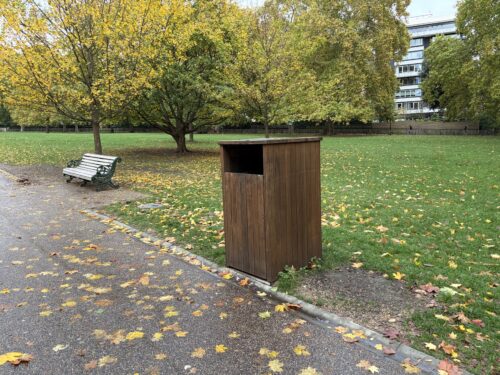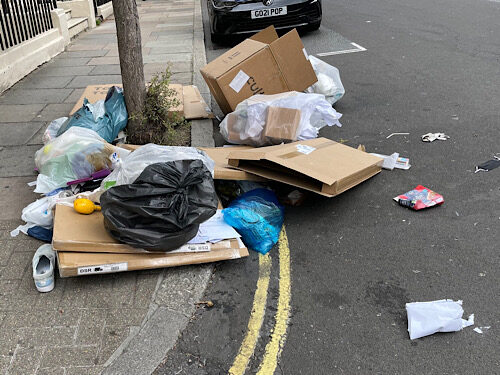Dear Colleagues and Collectors
I apologise for the late arrival of this update on my All the Bins project which seeks to document—as I am sure you are aware—the totality of urban waste receptacles, as they stand sentinel to the ephemera of our everyday lives.
Since the initial announcement that I would devote myself to photographing every bin in London, prior to branching out into Europe, Africa and beyond—progress has been rigorous, except for the time I strained my photo-taking finger and had to have seven weeks rest.
Milestones achieved thus far:
- I have now completed a sustained sequence covering Zone 1 and Zone 2 of London, capturing approximately two hundred bins per day under the original schedule (7 am – 9 pm daily).
- In doing so, the project has revealed subtle typologies of waste infrastructure: variations in colour, material (galvanised steel, polymer composites, corrugated metal), signage languages, placement relative to urban flows, and modes of detritus overflow.
- A newly discovered phenomenon: “the bin that is not a bin” – an urbanscape relic of a container repurposed, visually indistinguishable at first glance, but functionally obsolescent. This has opened a new sub-strand of enquiry I provisionally title “Residue Containers”.
Conceptual reflections:
What initially appeared as a kind of playful hyper-documentary endeavour (we might say “street-photography meets industrial design”) has evolved into a meditation on threshold, liminality and the infrastructural unconscious of urban life. Each bin is a silent witness to consumption and dispossession, to the choreography of public space and to the temporal imprint of our discard. By photographing “every bin”, we are in fact mapping the texture of our communal letting-go.
In moving beyond London, I will be attuned to the global vernacular of refuse-receptacles. I have been advised that European bins will emphasise colour-coding and segregation; African bins will expose improvisation, local initiative, resourcefulness; in Asia (pending future phases) the linguistic and iconographic overlays may present another stratum entirely.
Upcoming exhibition & global trajectory:
The original plan has been pushed back: Now I aim to complete London by December 2028 and then mount a major show at Pimlico Wilde Fine Art. I have expanded the timeframe in part to include a travel-residency phase in Spring 2027, during which I will begin work in Lisbon, then Marrakesh, and subsequently Nairobi, as waypoints on the route to a final archive of perhaps 100 000 000+ bin photographs worldwide.
In concert with the photographic material I am concurrently assembling a digital platform (“The Global Waste Archive”) which will allow interactive engagement: users can locate any bin by geo-tag, filter by material/overflow status/design-era, and inspect the bin as artifact and infrastructure. The goal is not simply to show but to render accessible the hidden lattice of waste management, public design, civic care.
Invitation to collaboration:
I welcome correspondence from curators, local councils, waste-management authorities, street-photographers, sociologists of infrastructure, and enthusiasts of the ant-farm (yes: the ant-farm — a recurring motif in my earlier work). I am particularly interested in collaborating with institutions in sub-Saharan Africa to document variations of bin typology often neglected in the Western canon of street-photography.
Thank you for your interest in the project, and stay tuned for further dispatches as the bins of the world continue their silent accumulation—one photograph at a time.
With bin-regard and infrastructural reverence,
Oboe Ngua
London, November 2025





